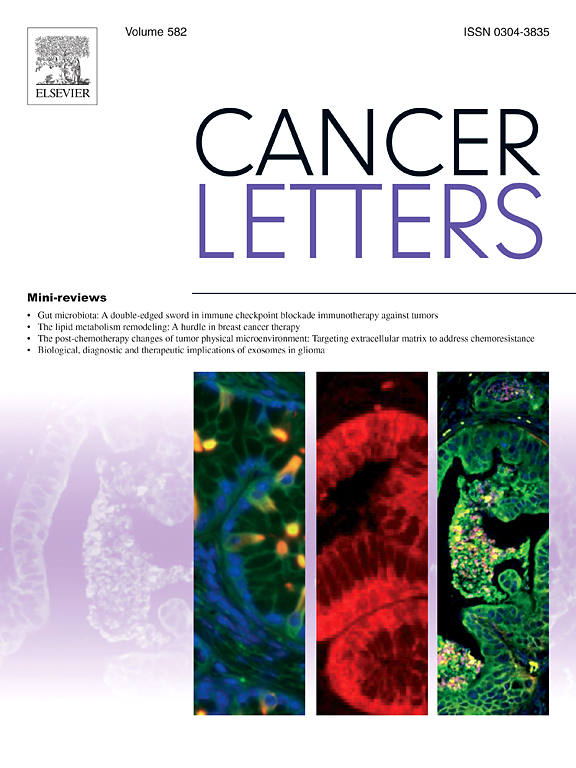Tumor immune microenvironment in pancreatic ductal adenocarcinoma revisited – Exploring the “Space”
IF 9.1
1区 医学
Q1 ONCOLOGY
引用次数: 0
Abstract
Pancreatic ductal adenocarcinoma (PDAC) remains one of the most deadly malignancies with a highly immunosuppressive tumor immune microenvironment (TIME) that hinders effective therapy. PDAC is characterized by significant heterogeneity in immune cell composition, spatial distribution and activation states, which impacts tumor progression and treatment response. Tumour-infiltrating lymphocytes (TILs), including CD4+ T-helper cells, CD8+ cytotoxic T-cells and FOXP3+ regulatory T-cells, play a key role in immune regulation, yet PDAC is largely an immunologically “cold” tumour with limited effector T-cell infiltration. The surrounding cellular microenvironment, particularly Cancer Associated Fibroblasts (CAFs) and macrophages, contributes to immune evasion by promoting a fibrotic and desmoplastic barrier that limits TIL infiltration. The prognostic significance of TILs is increasingly recognized, with higher densities correlating with improved survival, whereas regulatory T-cell infiltration and immunosuppressive stromal interactions are associated with poor outcomes. Emerging therapeutic strategies targeting the TIME (e.g., CAFs), immune checkpoint inhibitors, and TIL-based therapies offer the potential to overcome resistance. Future research must focus on optimizing immunotherapy strategies and unravelling the complex stromal-immune interactions to improve clinical translation.
再论胰腺导管腺癌的肿瘤免疫微环境--探索 "空间"
胰腺导管腺癌(PDAC)仍然是最致命的恶性肿瘤之一,其高度免疫抑制的肿瘤免疫微环境(TIME)阻碍了有效的治疗。PDAC具有免疫细胞组成、空间分布和激活状态的显著异质性,影响肿瘤进展和治疗反应。肿瘤浸润淋巴细胞(til),包括CD4+ t辅助细胞、CD8+细胞毒性t细胞和FOXP3+调节性t细胞,在免疫调节中发挥关键作用,但PDAC在很大程度上是一种免疫“冷”肿瘤,效应t细胞浸润有限。周围的细胞微环境,特别是癌症相关成纤维细胞(CAFs)和巨噬细胞,通过促进限制TIL浸润的纤维化和结缔组织增生屏障,有助于免疫逃避。TILs的预后意义越来越被认识到,较高的密度与生存率的提高相关,而调节性t细胞浸润和免疫抑制性基质相互作用与不良预后相关。新兴的针对TIME的治疗策略(例如,CAFs)、免疫检查点抑制剂和基于til的治疗提供了克服耐药性的潜力。未来的研究必须集中在优化免疫治疗策略和揭示复杂的基质-免疫相互作用,以提高临床翻译。
本文章由计算机程序翻译,如有差异,请以英文原文为准。
求助全文
约1分钟内获得全文
求助全文
来源期刊

Cancer letters
医学-肿瘤学
CiteScore
17.70
自引率
2.10%
发文量
427
审稿时长
15 days
期刊介绍:
Cancer Letters is a reputable international journal that serves as a platform for significant and original contributions in cancer research. The journal welcomes both full-length articles and Mini Reviews in the wide-ranging field of basic and translational oncology. Furthermore, it frequently presents Special Issues that shed light on current and topical areas in cancer research.
Cancer Letters is highly interested in various fundamental aspects that can cater to a diverse readership. These areas include the molecular genetics and cell biology of cancer, radiation biology, molecular pathology, hormones and cancer, viral oncology, metastasis, and chemoprevention. The journal actively focuses on experimental therapeutics, particularly the advancement of targeted therapies for personalized cancer medicine, such as metronomic chemotherapy.
By publishing groundbreaking research and promoting advancements in cancer treatments, Cancer Letters aims to actively contribute to the fight against cancer and the improvement of patient outcomes.
 求助内容:
求助内容: 应助结果提醒方式:
应助结果提醒方式:


